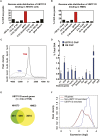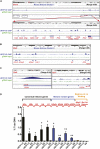A novel role for the Pol I transcription factor UBTF in maintaining genome stability through the regulation of highly transcribed Pol II genes
- PMID: 25452314
- PMCID: PMC4315294
- DOI: 10.1101/gr.176115.114
A novel role for the Pol I transcription factor UBTF in maintaining genome stability through the regulation of highly transcribed Pol II genes
Abstract
Mechanisms to coordinate programs of highly transcribed genes required for cellular homeostasis and growth are unclear. Upstream binding transcription factor (UBTF, also called UBF) is thought to function exclusively in RNA polymerase I (Pol I)-specific transcription of the ribosomal genes. Here, we report that the two isoforms of UBTF (UBTF1/2) are also enriched at highly expressed Pol II-transcribed genes throughout the mouse genome. Further analysis of UBTF1/2 DNA binding in immortalized human epithelial cells and their isogenically matched transformed counterparts reveals an additional repertoire of UBTF1/2-bound genes involved in the regulation of cell cycle checkpoints and DNA damage response. As proof of a functional role for UBTF1/2 in regulating Pol II transcription, we demonstrate that UBTF1/2 is required for recruiting Pol II to the highly transcribed histone gene clusters and for their optimal expression. Intriguingly, lack of UBTF1/2 does not affect chromatin marks or nucleosome density at histone genes. Instead, it results in increased accessibility of the histone promoters and transcribed regions to micrococcal nuclease, implicating UBTF1/2 in mediating DNA accessibility. Unexpectedly, UBTF2, which does not function in Pol I transcription, is sufficient to regulate histone gene expression in the absence of UBTF1. Moreover, depletion of UBTF1/2 and subsequent reduction in histone gene expression is associated with DNA damage and genomic instability independent of Pol I transcription. Thus, we have uncovered a novel role for UBTF1 and UBTF2 in maintaining genome stability through coordinating the expression of highly transcribed Pol I (UBTF1 activity) and Pol II genes (UBTF2 activity).
© 2015 Sanij et al.; Published by Cold Spring Harbor Laboratory Press.
Figures






References
-
- Bartkova J, Horejsi Z, Koed K, Kramer A, Tort F, Zieger K, Guldberg P, Sehested M, Nesland JM, Lukas C, et al. . 2005. DNA damage response as a candidate anti-cancer barrier in early human tumorigenesis. Nature 434: 864–870. - PubMed
Publication types
MeSH terms
Substances
Associated data
- Actions
- Actions
Grants and funding
LinkOut - more resources
Full Text Sources
Other Literature Sources
Molecular Biology Databases
Research Materials
